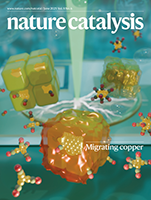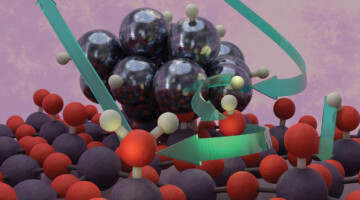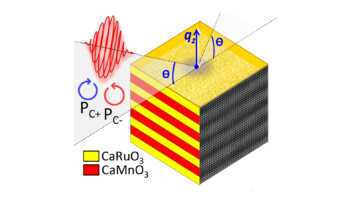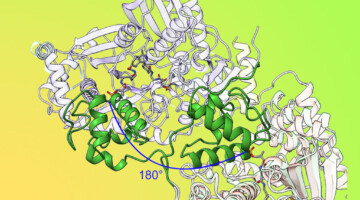 Operando probing dynamic migration of copper carbonyl during electrocatalytic CO2 reduction June 25, 2025 - In their work, Peidong Yang and colleagues reveal the dynamic evolution from faceted Cu nanocatalysts into metallic nanograins during CO2 reduction driven by the surface migration of electrogenerated copper carbonyl. Read more »
Operando probing dynamic migration of copper carbonyl during electrocatalytic CO2 reduction June 25, 2025 - In their work, Peidong Yang and colleagues reveal the dynamic evolution from faceted Cu nanocatalysts into metallic nanograins during CO2 reduction driven by the surface migration of electrogenerated copper carbonyl. Read more » Multimetallic Systems Convey Cost-Effective Hydrogen Storage June 24, 2025 - A bimetallic material (Pd-Ni) produces hydrogen-active nanopockets that improve the efficiency and lower the cost of hydrogen storage systems. Mechanistic understanding of a Pd-Ni bimetallic system paves the way to design cost-effective hydrogen storage, opening new opportunities to develop reliable energy technologies necessary to advance the energy industry. Read more »
Multimetallic Systems Convey Cost-Effective Hydrogen Storage June 24, 2025 - A bimetallic material (Pd-Ni) produces hydrogen-active nanopockets that improve the efficiency and lower the cost of hydrogen storage systems. Mechanistic understanding of a Pd-Ni bimetallic system paves the way to design cost-effective hydrogen storage, opening new opportunities to develop reliable energy technologies necessary to advance the energy industry. Read more » Efficient Upcycling of Plastic Waste into Useful Liquid Fuels June 20, 2025 - Researchers found a way to turn single-use plastics (e.g., grocery bags and packaging) into useful liquid fuels, like components of gasoline or diesel, without needing high heat, rare metals, or added chemicals. The work presents a promising pathway to address the global plastic waste crisis, with both environmental and economic advantages. Read more »
Efficient Upcycling of Plastic Waste into Useful Liquid Fuels June 20, 2025 - Researchers found a way to turn single-use plastics (e.g., grocery bags and packaging) into useful liquid fuels, like components of gasoline or diesel, without needing high heat, rare metals, or added chemicals. The work presents a promising pathway to address the global plastic waste crisis, with both environmental and economic advantages. Read more » A New Twist for Superconductivity in Bilayer Graphene June 20, 2025 - In a study of twisted bilayer graphene (TBG) systems, researchers found intriguing spectroscopic features in a superconducting “magic-angle” TBG—features that are absent in non-superconducting TBG. The results provide crucial information on superconductivity in magic-angle TBG for next-gen electronics and advanced energy technologies. Read more »
A New Twist for Superconductivity in Bilayer Graphene June 20, 2025 - In a study of twisted bilayer graphene (TBG) systems, researchers found intriguing spectroscopic features in a superconducting “magic-angle” TBG—features that are absent in non-superconducting TBG. The results provide crucial information on superconductivity in magic-angle TBG for next-gen electronics and advanced energy technologies. Read more » ALS Captures Structure of Engineered Protein, Opening New Options to Treat IBD June 17, 2025 - Researchers use the ALS to confirm the structure of an engineered immune protein that could open new opportunities to treat inflammatory bowel disease. Read more »
ALS Captures Structure of Engineered Protein, Opening New Options to Treat IBD June 17, 2025 - Researchers use the ALS to confirm the structure of an engineered immune protein that could open new opportunities to treat inflammatory bowel disease. Read more » Catching “Hydrogen Spillover” onto a Catalytic Surface May 27, 2025 - Researchers uncovered the precise mechanism of hydrogen spillover (H2 splitting and migration) onto a catalytic surface by watching it happen under various conditions. The research lays the foundation for designing more efficient catalysts and storage materials essential for next-generation hydrogen energy technologies. Read more »
Catching “Hydrogen Spillover” onto a Catalytic Surface May 27, 2025 - Researchers uncovered the precise mechanism of hydrogen spillover (H2 splitting and migration) onto a catalytic surface by watching it happen under various conditions. The research lays the foundation for designing more efficient catalysts and storage materials essential for next-generation hydrogen energy technologies. Read more » A Deeper Look into Emergent Magnetism at Interfaces May 16, 2025 - Researchers shed new light on interfacial ferromagnetism in superlattices of alternating magnetic layers. By advancing our understanding of atomic-level interactions at magnetic interfaces, this work expands the scope of traditional interface studies and lays the groundwork for future innovations in magnetic storage and spintronics. Read more »
A Deeper Look into Emergent Magnetism at Interfaces May 16, 2025 - Researchers shed new light on interfacial ferromagnetism in superlattices of alternating magnetic layers. By advancing our understanding of atomic-level interactions at magnetic interfaces, this work expands the scope of traditional interface studies and lays the groundwork for future innovations in magnetic storage and spintronics. Read more » Building a Gated-Access Fast Lane for Ions April 25, 2025 - In organic conductors where charge is carried by both electrons and ions, scientists have discovered a way to make the ions move more than ten times faster than in comparable ion-transport methods. The results could apply to a host of areas, including improved battery charging, biosensing, soft robotics, and neuromorphic computing. Read more »
Building a Gated-Access Fast Lane for Ions April 25, 2025 - In organic conductors where charge is carried by both electrons and ions, scientists have discovered a way to make the ions move more than ten times faster than in comparable ion-transport methods. The results could apply to a host of areas, including improved battery charging, biosensing, soft robotics, and neuromorphic computing. Read more » Deep-Dive Inspection of a Molecular Assembly Line April 21, 2025 - By locking down certain movable parts of a modular drug-building protein, researchers learned new details about how carrier proteins transfer the product protein between modules. The results offer insights that could enable scientists to design and create new and improved medicines, such as antibiotics, using synthetic biology. Read more »
Deep-Dive Inspection of a Molecular Assembly Line April 21, 2025 - By locking down certain movable parts of a modular drug-building protein, researchers learned new details about how carrier proteins transfer the product protein between modules. The results offer insights that could enable scientists to design and create new and improved medicines, such as antibiotics, using synthetic biology. Read more » Polyethylene Upcycling to Liquid Alkanes in Molten Salts under Neat and External Hydrogen Source-Free Conditions April 7, 2025 - Researchers found a way to turn single-use plastics (e.g., grocery bags and packaging) into useful liquid fuels, like components of gasoline or diesel, without needing high heat, rare metals, or added chemicals. The work presents a promising pathway to address the global plastic waste crisis, with both environmental and economic advantages. Read more »
Polyethylene Upcycling to Liquid Alkanes in Molten Salts under Neat and External Hydrogen Source-Free Conditions April 7, 2025 - Researchers found a way to turn single-use plastics (e.g., grocery bags and packaging) into useful liquid fuels, like components of gasoline or diesel, without needing high heat, rare metals, or added chemicals. The work presents a promising pathway to address the global plastic waste crisis, with both environmental and economic advantages. Read more »